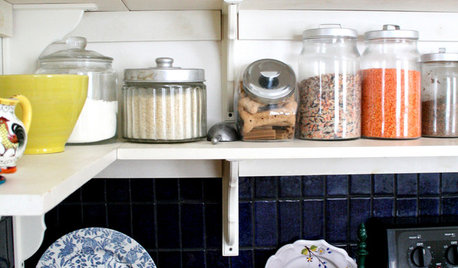Loss of water pressure after 'T'ing' supply lines
OrchidOCD
12 years ago
Related Stories

DISASTER PREP & RECOVERYRemodeling After Water Damage: Tips From a Homeowner Who Did It
Learn the crucial steps and coping mechanisms that can help when flooding strikes your home
Full Story
KITCHEN DESIGNDisplaying Kitchen Supplies — Hot or Not?
Do some kitchens just beg for a cozy row of canisters and gear for all to see? Have a look and let us know what you think
Full Story
MOST POPULARWhat to Do After a Hurricane or Flood
How you treat your home after a natural disaster can make all the difference in its future livability — and your own personal safety
Full Story
LIFEHow to Prepare for and Live With a Power Outage
When electricity loss puts food, water and heat in jeopardy, don't be in the dark about how to stay as safe and comfortable as possible
Full Story
MOST POPULAR9 Real Ways You Can Help After a House Fire
Suggestions from someone who lost her home to fire — and experienced the staggering generosity of community
Full Story
GREAT HOME PROJECTSHow to Switch to a Tankless Water Heater
New project for a new year: Swap your conventional heater for an energy-saving model — and don’t be fooled by misinformation
Full Story
FRONT YARD IDEASBefore and After: Front Lawn to Prairie Garden
How they did it: Homeowners create a plan, stick to it and keep the neighbors (and wildlife) in mind
Full Story
HOLIDAYS10 Ways Your Christmas Tree Can Live On After the Holidays
Learn how to recycle your Christmas tree and reap benefits for the environment
Full Story
EXTERIORSWhere Front Yards Collide: Property Lines in Pictures
Some could be twins; others channel the Odd Couple. You may never look at property boundaries the same way again
Full Story
SAVING WATER11 Ways to Save Water at Home
Whether you live in a drought-stricken area or just want to help preserve a precious resource, here are things you can do to use less water
Full Story



brickeyee
OrchidOCDOriginal Author
Related Professionals
North New Hyde Park Handyman · East Tulare County Kitchen & Bathroom Remodelers · Plainview Kitchen & Bathroom Remodelers · Wood River Kitchen & Bathroom Remodelers · Apex Kitchen & Bathroom Remodelers · Brentwood Kitchen & Bathroom Remodelers · Buffalo Grove Kitchen & Bathroom Remodelers · Park Ridge Kitchen & Bathroom Remodelers · Saint Augustine Kitchen & Bathroom Remodelers · South Plainfield Kitchen & Bathroom Remodelers · Spokane Kitchen & Bathroom Remodelers · Toledo Kitchen & Bathroom Remodelers · Fairmont Kitchen & Bathroom Remodelers · Travilah Kitchen & Bath Fixtures · Kiryas Joel Appliancesbus_driver
OrchidOCDOriginal Author
lazypup
david_cary
GreenDesigns
OrchidOCDOriginal Author